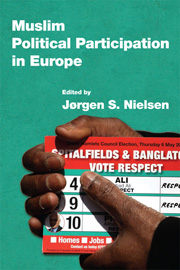Book contents
- Frontmatter
- Contents
- List of tables and figures
- 1 Introduction
- Part One Laying foundations: national and local elections
- Part Two Participation as integration
- Part Three Institutions as gateways
- 11 Creating the image of European Islam: the European Council for Fatwa and Research and Ireland
- 12 The political participation of Polish Muslim Tatars – the result of or the reason for integration? From Teutonic wars to the Danish cartoons affair
- 13 The Alevi quest in Europe through the redefinition of the Alevi movement: recognition and political participation, a case study of the FUAF in France
- 14 Leicester Muslims: citizenship, race and civil religion
- Part Four Breaking the bounds
- Notes on the contributors
- Index
11 - Creating the image of European Islam: the European Council for Fatwa and Research and Ireland
from Part Three - Institutions as gateways
Published online by Cambridge University Press: 05 October 2013
- Frontmatter
- Contents
- List of tables and figures
- 1 Introduction
- Part One Laying foundations: national and local elections
- Part Two Participation as integration
- Part Three Institutions as gateways
- 11 Creating the image of European Islam: the European Council for Fatwa and Research and Ireland
- 12 The political participation of Polish Muslim Tatars – the result of or the reason for integration? From Teutonic wars to the Danish cartoons affair
- 13 The Alevi quest in Europe through the redefinition of the Alevi movement: recognition and political participation, a case study of the FUAF in France
- 14 Leicester Muslims: citizenship, race and civil religion
- Part Four Breaking the bounds
- Notes on the contributors
- Index
Summary
The recent focus on European Islam has sparked an interest in establishing representative Muslim networks that seemingly span the continent of Europe. However, unifying European Muslims onto a single political platform has largely been an elusive process for Europe's Muslim communities. The image of Muslim representation in Europe has been aided by international organisations, such as the European Council for Fatwa and Research, whose prestigious network of esteemed scholars purportedly address the concerns of western Muslims, while acting as one of the few representative voices of European Islam. Although this image of a unified ‘European Islam’ would indeed, at first glance, appear to be an impressive accomplishment for Europe's Muslim communities, it is not the outcome of local efforts by European Muslims at the grassroots level. Rather, organisations like the European Council for Fatwa and Research are the result of a top-down approach intended to project an image of European Islam. This has shaped the development of Muslim communities in countries, like Ireland, where transnational influences have promoted the vision of a globalised Islam. Efforts to fabricate this image of European Islam have remarkably transformed Dublin into the seat of the European Council for Fatwa and Research, despite Ireland having one of the smallest Muslim populations in Western Europe. This chapter will explore the role of external influences on the construction of the image of European Islam and on the notion of Muslim representation in Europe, with particular reference to the historical development of Ireland's Muslim community.
- Type
- Chapter
- Information
- Muslim Political Participation in Europe , pp. 215 - 238Publisher: Edinburgh University PressPrint publication year: 2013



